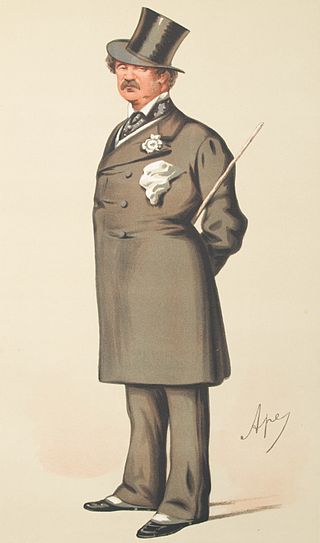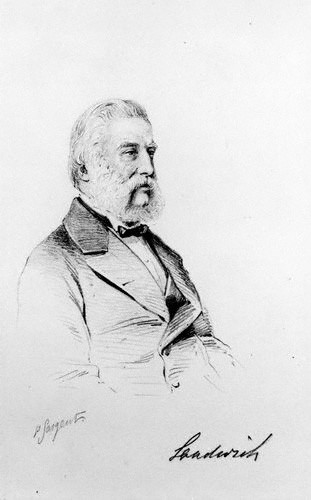Related Research Articles

Vice-Admiral Frederick Spencer, 4th Earl Spencer, KG, CB, PC, styled The Honourable Frederick Spencer until 1845, was a British naval commander, courtier, and Whig politician. He initially served in the Royal Navy and fought in the Napoleonic Wars and the Greek War of Independence, eventually rising to the rank of Vice-Admiral. He succeeded his elder brother as Earl Spencer in 1845 and held political office as Lord Chamberlain of the Household between 1846 and 1848 and as Lord Steward of the Household between 1854 and 1857. In 1849 he was made a Knight of the Garter.

Henry Hardinge, 1st Viscount Hardinge, was a British Army officer and politician. After serving in the Peninsular War and the Waterloo Campaign he became Secretary at War in Wellington's ministry. After a tour as Chief Secretary for Ireland in 1830 he became Secretary at War again in Sir Robert Peel's cabinet. He went on to be Governor-General of India at the time of the First Anglo-Sikh War and then Commander-in-Chief of the Forces during the Crimean War.
Major-General Lord Charles Wellesley was an Anglo-Irish soldier, Conservative politician, and courtier from the aristocratic Wellesley family. He was the younger son of Prime Minister Arthur Wellesley, 1st Duke of Wellington.

Lord Alfred Henry Paget was a British soldier, courtier and Liberal politician who sat in the House of Commons between 1837 and 1865.

Admiral Sir James Whitley Deans Dundas, GCB was a Royal Navy officer. He took part in the Napoleonic Wars, first as a junior officer when he took part in the Anglo-Russian invasion of Holland in Autumn 1799 and later as a commander when he was in action at Copenhagen Dockyard shortly after the capture of that City in August 1807. He also served as Whig Member of Parliament for Greenwich and then for Devizes and became First Naval Lord in the First Russell ministry in July 1847 and in that role his service was dominated by the needs of Whig party. He was appointed Commander-in-Chief in the Mediterranean in 1852 and led all naval operations in the Black Sea including the bombardment of Sevastopol in October 1854 during the Crimean War.
The Master of the Buckhounds was an officer in the Master of the Horse's department of the British Royal Household. The holder was also His/Her Majesty's Representative at Ascot. The role was to oversee a hunting pack; a buckhound is smaller than a staghound and used for coursing the smaller breeds of deer, especially fallow deer. The position was abolished by the Civil List Act 1901.

The Captain of the King's Bodyguard of the Yeomen of the Guard is a UK Government post usually held by the Government Deputy Chief Whip in the House of Lords. The present Captain is The Baroness Wheeler, who was appointed to the position in the Starmer ministry in July 2024.

Lichfield is a constituency in Staffordshire represented in the House of Commons of the UK Parliament since 2024 by Dave Robertson of the Labour Party.

The Master of the Household is the operational head of the "below stairs" elements of the Royal Households of the United Kingdom. The role has charge of the domestic staff, from the Royal Kitchens, the pages and footmen, to the housekeeper and their staff. The appointment has its origin in the household reforms of 1539-40; it is under the supervision of the Lord Steward.
General James Alexander St Clair-Erskine, 3rd Earl of Rosslyn PC, DL, styled Lord Loughborough from 1805 to 1837, was a Scottish soldier and Tory politician. A General in the British Army, he also held political office as Master of the Buckhounds between 1841 and 1846 and again in 1852 and as Under-Secretary of State for War in 1859.
This is a list of people who have served as Lord Lieutenant of Herefordshire. Before the English Civil War, the lieutenancy of Herefordshire was always held by the Lord Lieutenant of Wales, but after the Restoration, its lieutenants were appointed separately. Since 1714, all the Lord Lieutenants have also been Custos Rotulorum of Herefordshire.

Charles John Colville, 1st Viscount Colville of Culross,, known as The Lord Colville of Culross between 1849 and 1902, was a British nobleman, Conservative politician, courtier, and painter.
The office of Master of the Ceremonies was established by King James VI and I. The Master's duties were to receive foreign dignitaries and present them to the monarch at court. Below is a list of known holders until the replacement of the office by the Marshal of the Diplomatic Corps in 1920.

John William Montagu, 7th Earl of Sandwich PC, styled Viscount Hinchingbrooke from 1814 to 1818, was a British peer and Conservative politician. He served under Lord Derby as Captain of the Honourable Corps of Gentlemen-at-Arms in 1852 and as Master of the Buckhounds between 1858 and 1859.
Gentleman of the Bedchamber was a title in the Royal Household of the Kingdom of England from the 11th century, later used also in the Kingdom of Great Britain. A Lord of the Bedchamber was a courtier in the Royal Household, the term being first used in 1718. The duties of the Lords and Gentlemen of the Bedchamber originally consisted of assisting the monarch with dressing, waiting on him when he ate, guarding access to his bedchamber and closet, and providing companionship. Such functions became less important over time, but provided proximity to the monarch; the holders were thus trusted confidants and often extremely powerful. The offices were in the gift of The Crown and were originally sworn by Royal Warrant directed to the Lord Chamberlain.

George Stevens Byng, 2nd Earl of Strafford, PC, styled Viscount Enfield between 1847 and 1860, of Wrotham Park in Middlesex and of 5 St James's Square, London, was a British peer and Whig politician.
Gentleman of the Horse was a position in the stables department of the British Royal Court, subordinate only to the Master of the Horse. It existed from 1693 until abolished in 1782, and carried a salary of £256.
Admiral John Colville, 9th Lord Colville of Culross, styled Master of Colville from 1786 to 1811, was a Royal Navy officer who served as Commander-in-Chief, Cork Station.
References
- ↑ The Royal Kalendar and Court and City Register for England, Scotland, Ireland and the Colonies: For the Year .... 1833. 1833. p. 2-PA127. Retrieved 30 April 2019.
- ↑ "No. 24121". The London Gazette . 11 August 1874. p. 3965.
- 1 2 Chris Cook and Brendan Keith, British Historical Facts 1830–1900, Macmillan 1975, p. 27
- ↑ Financial Reform Tracts: Civil list. Financial Reform Association. 1851. p. 20. Retrieved 30 April 2019.
- ↑ Murray, J. (1852). Murray's Official Handbook of Church and State: Containing the Names, Duties, and Powers of the Principal Civil, Military, Judicial, and Ecclesiastical Authorities of the United Kingdom and Colonies; with Lists of the Members of the Legislature, Peers, Baronets, &c. &c. p. 14. Retrieved 30 April 2019.
- ↑ "No. 16581". The London Gazette . 10 March 1812. p. 450.
- ↑ "No. 17280". The London Gazette . 26 August 1817. p. 1829.
- ↑ Nichols, J. (1851). The Gentleman's Magazine. R. Newton. p. 202. Retrieved 30 April 2019.
He was for forty years Chief Equerry and Clerk Marshal in the household of King George III. and George IV. ...
- ↑ "No. 18711". The London Gazette . 27 July 1830. p. 1580.
- ↑ "No. 20557". The London Gazette . 2 January 1846. p. 9.
- ↑ "No. 19524". The London Gazette . 21 July 1837. p. 1881.
- ↑ "No. 20017". The London Gazette . 10 September 1841. p. 2274.
- ↑ "No. 20621". The London Gazette . 10 July 1846. p. 2534.
- ↑ "No. 20057". The London Gazette . 4 January 1842. p. 2.
- ↑ "No. 21419". The London Gazette . 8 March 1853. p. 709.
- ↑ "No. 27632". The London Gazette . 1 January 1904. p. 3.
- ↑ "No. 28184". The London Gazette . 9 October 1908. p. 7295.
- R.O. Bucholz (2006). "The stables: Avenor, Chief Equerry and Clerk Martial 1660–1837". Office-Holders in Modern Britain: Volume 11 (revised): Court Officers, 1660–1837. Institute of Historical Research. Retrieved 20 August 2011.